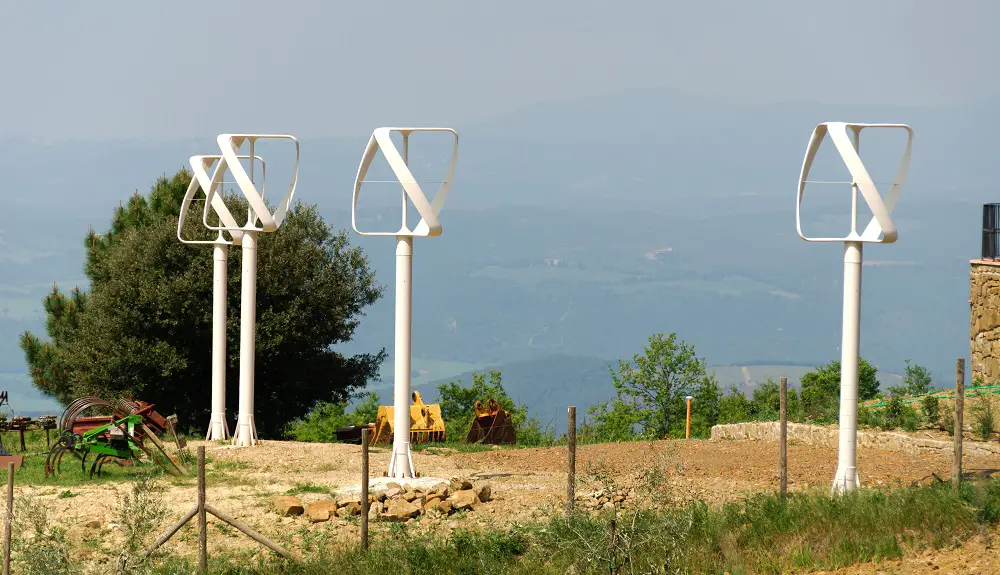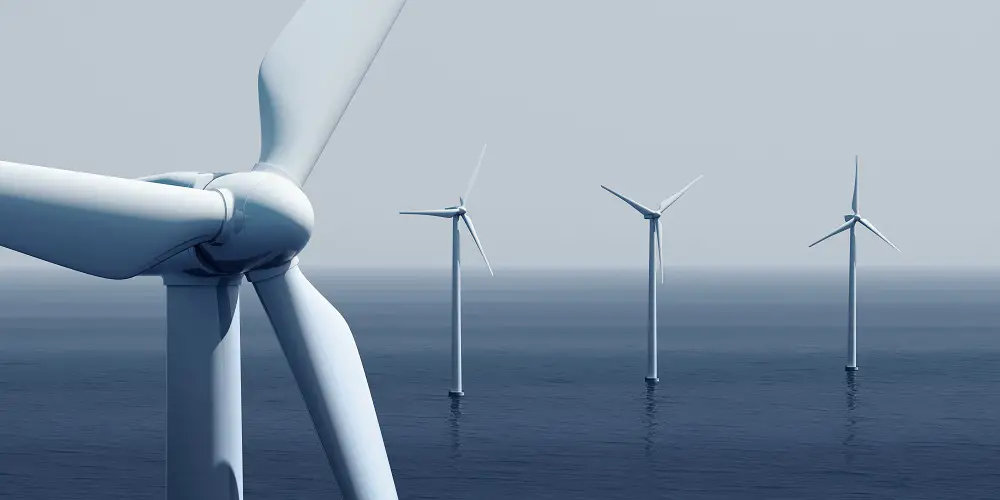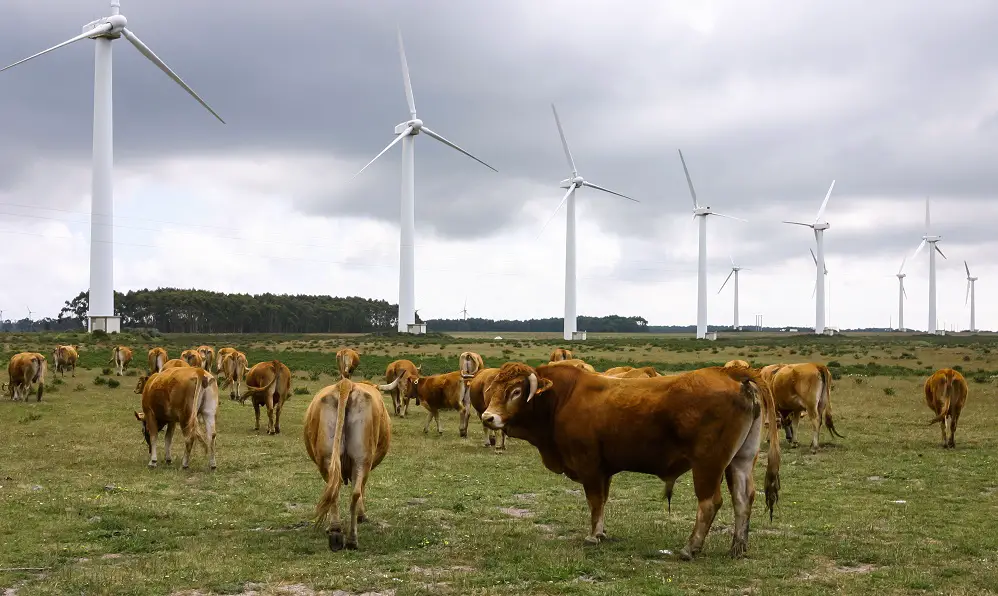This is a difficult question to answer as there are so many variables. The first consideration is the size of the turbine, whether you're referring to a small personal set up or one of the towering 4MW power structures seen in wind farms.
We discuss both in this article to give you some understanding of how much a wind turbine costs and any associated expenses.
What is a Wind Turbine

A wind turbine is a structure used to harness the kinetic energy from the wind, and with the use of an inbuilt generator, turn it into electrical energy. This is done via powerful blades that turn in the direction where the greatest wind harvest is possible, a motor, and a generator.
All wind turbines work on the same principle, however the largely white, towering structures that you see in wind farms, capture the wind to convert into electricity to supply the national grid.
Small wind turbines can be floor or rooftop mounted to supply energy to individual properties. For those that live in isolated rural areas, or regions that suffer from regular power loss, turbines are an ideal solution or back-up system.
There are portable wind turbines that, providing the wind speed is great enough, supply power to RV's and boats.
Factors that Affect the Cost of a Wind Turbine
The initial outlay isn't the only financial consideration of a wind turbine. Maintenance and repair costs should be factored in, which could be extensive as the expected life span of a turbine is between 20 and 25 years.
Size
Wind turbines for individual properties or small communities are vastly smaller than the HAWT, Horizontal Axis Wind Turbine models seen on and offshore.
The difference in costs is a few thousand to a few million dollars.
Power Output
The rating of the generator and its maximum electricity production capacity is inherent to the overall cost of a wind turbine.
Siting Costs
Land prices vary from region to region. Land should be near to pylons and an overhead power line system to distribute electricity to substations, otherwise, the cost of utility system upgrades should be factored in.
Areas with reliable road networks are preferred, however, areas with most consistent and constant high wind speeds are often in rural regions, away from habitation.
Legal and Consultation Fees
Seeking regulatory approval can be a long and drawn-out process. Lawyers fees mount as it often takes several expensive court cases to persuade authorities and landowners to allow wind turbine erection.
Additional Equipment
The purchaser should also consider any transformers required, along with necessary protection and metering equipment that doesn't come standard.
Maintenance and Repair
Both home and commercial wind turbines have, in theory, 25-year life expectancies. Maintenance fees and repair costs should be factored into any initial outlay.
The Cost of Home and Domestic Models

Home sized wind turbines have multiple advantages. They are compact enough so as not to create an eyesore and are versatile.
The best home turbines have large power capacity, enough to power a houseful of electrical equipment, all year round. Even smaller, inexpensive models can subsidize your supply, greatly reducing your utility bills.
Size, wattage, voltage, and design are many features that impact the cost of home wind turbines.
Wattage Maximum
The amount of wattage that a wind turbine has determines the amount of power it can generate from its operation.
Large houses with multiple occupants invariably have several electrical products. To provide the required amount of power a family home requires, approximately 11000kw annually, at least 500w is recommended.
Wind turbines for individual use most commonly provide between 500 and 2000-watts.
Battery Voltage
A safe battery voltage is required to prevent the generator from overheating. Most high-end turbines have built-in safeguards such as aerodynamic braking systems and overcharge protection. In the event of storms and serious gusts, a turbine spinning out of control can burn out and damage the blades.
Most home turbines are compatible with multiple voltages, typically 12V and 24V.
Design
Home wind turbines should have a life span of 20-25 years, requiring as little maintenance as possible. To this end, they should feature high-quality, strong blades and all outer parts should be weather-proofed and built to last.
Additional Costs
Not all domestic wind turbines come equipped with a tower for floor mounting.
Conversion from DC voltage to 110v AC is a costly necessity, as are some surplus storage batteries.
The most efficient turbines tend to be those with low cut-in range. Models that operate when the wind speed is around 5-6mph produce more electricity in less windy conditions.
Home wind turbines are available at a cost of a few hundred dollars with the highest quality, most powerful models costing over $2000.
The marked savings on utility bills mean that most home wind turbines pay for themselves within a year, while the top-of-the-range models with the highest efficiency, take less than 6-months.
Horizontal Axis Wind Turbine(HAWT) Cost

Costs vary significantly depending on multiple criteria, however, there is a general rule of thumb for the cost of a commercial wind turbine.
The majority of wind turbines installed across the United States are 2-megawatt units.
Costing between $1.3 and $2.2 million per megawatt of installed capacity puts the initial cost between $3 and $4 million.
This is purely a guide price for onshore turbines, however, it is inclusive of all installation fees.
Offshore wind turbines are notoriously more expensive, usually about 4 times more. These incredibly high installation costs are off-set by their unrivaled energy production capabilities.
Incentives
Renewable energy is the way forward, encouraging society to become less reliant on dwindling supplies of fossil fuels.
However, wind farming is too costly for most people to consider. However, taxes and incentives are available to help with purchasing a wind turbine. Combine this with the opportunity to reduce your energy bills and have an additional income, the idea becomes more inviting.
Businesses and Wind Turbines
Businesses that are looking to reduce their carbon footprint, become greener, and more ethical should look into renewable energy, sourced from wind.
Businesses with high energy requirements would benefit from a 50Kw – 500Kw wind turbine to produce their power.
In return they would see:
- Reduced energy bills
- Additional income – achieved by exporting electricity
- Meet carbon reduction targets
- Increase green compliance
Turbines below 1000Kw cost in the region of $3000 - $8000 per KW.
This usually includes all associated costs for installation and an annual fee is payable for ongoing maintenance.
The Cost of the World's Largest Wind Turbine
SeaTitan is the largest wind turbine in the world. With a rated power capacity of 10MW, and rotors twice the length of a football field. In 2015, the average cost per megawatt was $2,000,000. Meaning, at 10MW, SeaTitan would cost $20,000,000.
SeaTitan has a hub height of 125-meters and has a high-temperature superconductor generator that operates at a speed of 10rpm. This makes it smaller and lighter than a conventional wind turbine generator.
The SeaTitan has gone through stringent off-shore testing in the harshest and most hazardous conditions.
It sailed through all of the tests and the makers are now in talks with potential partners to build and commercialize these giant wind turbines.
Wind Turbines On Farmland

Rural farmland is one of the most common sites for wind turbines. This may seem strange if you read the press and see that farmers are struggling to make ends meet due to poor crops and unreliable growing conditions.
You might be surprised to learn that wind farm operators lease land from farmers where there is sufficient space in consistent high wind areas.
As wind turbines leave 98% of the surrounding land undisturbed arable or livestock can still be farmed. Unlike sunshine and rain, the wind is a more dependable source and is virtually guaranteed to produce a set amount of energy.
Turbines require no fuel or water so they add nothing to a farmer's workload.
The farmer has a secure income to subsidize other earnings that last for a long time. Leases usually last for 30-40 years and not only the landowner benefits. There are annual payments of $3 -$7000 per turbine made to the host, and "Good Neighbour" payments to those whose land the turbines encroach upon.
The Bloomberg New Energy Finance predicts that by 2030, rural landowners will be reaping $900 million from land-leasing schemes.
Final Thoughts
As outlined above, wind turbine costs anywhere from $300 and $20,000,000.
Sometimes they cost nothing at all, if you're a landowner you can be paid to host a wind turbine.
At the moment, wind power accounts for less than 5% of all energy used in the USA.
As fossil fuel stocks reduce, the popularity of renewable energy will grow as it is cleaner, reliable, and cheaper.

